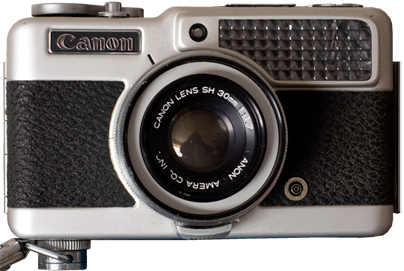
Format: 35mm Half-Frame
Approx. dates of manufacture: 1964 - 1966
Approx. original price: $75
Approx. street value: low-moderate
Throughout most of the 20th century, film sizes tended to get smaller. At the beginning of the century, most cameras took plates or film that were huge by modern standards. Kodak made a "detective" camera that got its name for being small and easily concealed—its negatives were 2½ inches square.
35mm, the "miniature" format, became popular after World War II as camera techology advanced to exploit it. The great thing about small negatives is that the cameras and lenses are smaller, lighter, and easier to handle. The bad part is that they don't enlarge as well. A small negative has to be enlarged (magnified) much more than a large negative to make the same sized print. And when you enlarge the image, you are enlarging the stucture of the image as well.
35mm became, more or less, the smallest format that sees widespread use. Minox and other "spy" cameras have a niche market; size 110 (popular for awhile in the 70s) had a short vogue, but the sub-miniature (smaller than 35mm) format was never popular enough to stay. In retrospect, it seems to be about as small as one can get and still achieve a quality that the mass-market expects. But that was not obvious; camera makers experimented with smaller sizes to see if another format might become popular—maybe even set a new standard.
.jpg) One of the more successful experiments in the sub-miniature format was the "half-frame" format. The camera used standard 35mm film but it took an
image that was ½ the size of a normal 35mm frame. Thus you got twice as many exposures per roll of film. Half-frames had some
popularity in the 1960s; Olympus came out with its famous Pen series,
and Canon answered with its Demi cameras (Demi is French for
"half").
One of the more successful experiments in the sub-miniature format was the "half-frame" format. The camera used standard 35mm film but it took an
image that was ½ the size of a normal 35mm frame. Thus you got twice as many exposures per roll of film. Half-frames had some
popularity in the 1960s; Olympus came out with its famous Pen series,
and Canon answered with its Demi cameras (Demi is French for
"half").
My Demi S was the third model in the line. The first one was simply the Demi, which set the standard configuration for the line. The second was the Color Demi, which was the same thing with colored (as opposed to black) leatherette. The Demi S upgraded the optics, from an ƒ/2.8 lens originally to an ƒ/1.7 lens, and bumped up the top shutter speed from 1/250 to 1/500.
This camera still has the selenium photo cell that runs the meter: it's that big faceted glass-thing on the camera's upper left side. They were big and not too great, but the nice thing about them is that they generated their own electrical current, so no batteries. A lot of cameras that are now a half-century old still have perfectly good, working light meters because they don't need batteries.
Half-frames had a following for a while—they were smaller and lighter than their full-frame rangefinder equivalents, which made them great for snapshots at the office or at family gatherings; places where you were never going to make a photo larger than a standard drug-store print. They could be easily tucked into a purse or a coat pocket. Plus, in the 60s, color film was expensive; getting twice as many shots on a roll had some economical value.
But half-frames never stayed. Their market was eaten away at the lower end by the light-weight, super-convenient Instamatic and such, and if you were going to pay for a quality camera, why not pay a little more and get a full-frame 35mm? By the late 60s and 70s, full-frame cameras were smaller and lighter, and the full-size 35mm cameras had interchangable lenses and lots of other nice accessories, and the experiment had run its course.
For more information: Canon Camera Museum
Camera manual: Orphan Cameras.com



